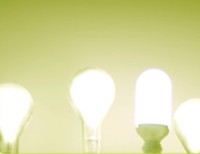What if the light bulb produced more than light?
 Talk about a light bulb
Talk about a light bulbmoment.
A professor of engineering at Edinburgh University recently
demonstrated for the first time to a wide audience his technology
that uses common every day lights to transmit data.
Harald Haas streamed a video through a desk lamp at Ted Global
2011 at Scotland’s Edinburgh International Conference Center in
July.
If commercialized, the technology not only creates a vast new
application for light, but also dramatically expands our now
limited wireless capacity. Imagine downloading your email from any
of the14 billion light bulbs installed in the world.
Haas’ technology swaps out our current way of transmitting data
- through radio frequency - with a new approach using visible light
from LED light bulbs. This is significant because we are running
out of radio frequency spectrum as our appetite for wireless
communication grows, Haas says.
The visible light spectrum, on the other hand, is enormous, with
about 10,000 times more capacity than radio frequency. Using light
instead of radio frequency would give us a lot more capacity for
our cell phones, wireless computers and other devices.
The energy implications are even more interesting.
First, the technology creates a new impetus for switching from
incandescent light bulbs to LEDs. Until now, LED champions have
argued their cause based on the light bulb’s energy efficiency.
It’s a good argument, but not one that always motivates the
consumer. With Haas’ technology the LED takes on new importance.
LED lights are necessary because they contain a semi-conductor;
incandescent light bulbs do not.
Second, the whole process of transmitting data through light is
more energy efficient than using radio frequency, according to
Haas. Think of it this way. We have 1.4 million cellular masts, or
base stations, that now allow us to transmit data through our 5
billion cell phones worldwide. These base stations use a lot of
energy, particularly for cooling, operating at only a five percent
efficiency level, according to Haas. What if instead we transmitted
data through the 14 billion light bulbs already installed
worldwide? Haas says he’s calculated the “energy budget” and found
light-based data transmission to be so efficient, it is virtually
free.
“It should be so cheap that it’s everywhere. Using the visible
light spectrum, which comes for free, you can piggy-back existing
wireless services on the back of lighting equipment,” he says.
The technology offers some other advantages as well,
particularly privacy, convenience and health assurances.
Light is more secure than radio waves. Light does not penetrate
walls and radio waves do. So it appears that it would much more
difficult to hack your calls via light wave than radio wave.
As for convenience, think of how you’re asked to switch off your
computer on an airline, so that you don’t interfere with radio
signals needed by the plane. If you were instead using the light
above your seat to access the Internet, you could keep the computer
on.
And last, for electric utilities, light-based transmission would
eliminate customer concerns that smart meters placed on homes cause
cancer. Industry research has not supported these claims.
Nonetheless utility customers in some states, particularly
California and Maine, have protested installation of smart meters,
themselves an energy efficiency device.
How does Haas’ technology work? It all looks pretty simple. He
switches on a desk lamp that uses a $3 LED light. The light beams
into a hole to a receiver. The receiver detects small changes made
in the light’s amplitude and converts those changes into an
electronic signal. Voila! A streaming video, showing flowers
opening, appears on a nearby screen. To stop the video, Haas simply
passes his hand in front of the light.
Haas hopes to see the necessary microchip fitted into every
lighting device: household lights, street lamps, cell phones,
overhead lights on planes, traffic lights. Of course, the road to
commercialization trips up many potential technologies. And he’s
still working on improving data speed. (He has achieved rates of 10
MBit/s per second and hopes to achieve and 100 MBit/s by the end of
this year.) But this is one to watch.
target=”_blank”>See his TED talk here.
Elisa Wood is a long-time energy business writer. See more
of her work at target=”_blank”>www.RealEnergyWriters.com
Source: www.realenergywriters.com

